5 key facts about this project
The New Berlin Skyline project is located in the heart of Berlin and aims to improve housing options through a design focused on vertical development. The concept involves stacking buildings alongside greenery, creating a fresh skyline that uses land effectively while encouraging community ties. By elevating residential structures, the design creates an environment that connects people with their surroundings and enhances urban living.
Design Concept
The main idea behind the project is to make use of height to increase urban density. Buildings are designed to match the height of those nearby, ensuring a consistent visual rhythm in the skyline. This design creates shared spaces between the stacked units, encouraging social interaction among residents and helping to build a sense of community in the neighborhood.
Green Integration
Green spaces are a crucial element of the design. Elevated above typical city pollution, these areas provide residents with a place to enjoy nature. They serve as communal hubs where people can gather, creating opportunities for socializing and relaxation. This connection to nature is designed to improve the quality of life for residents in a bustling urban environment.
Spatial Organization
The layout features a central circulation path that helps guide movement throughout the buildings. This central axis connects various apartment modules and ensures easy access to shared spaces. The flexible design of the living units meets different needs, accommodating various lifestyles and fostering a welcome sense of belonging among those who live there.
Architectural Materiality
Concrete is the primary material used in construction, selected for its strength and adaptability. This choice supports the overall modern design while linking the project to its urban context. The use of concrete also enhances the durability of the structures, making them well-suited for an evolving city like Berlin.
By focusing on height, community engagement, and green spaces, the design encourages a balance between urban living and connection to nature, shaping a new approach to residential environments in the city.



















































